




Your support is critical to our success.
Accepted Scientific Name: Coryphantha cornifera (DC.) Lem.
Cactées 35 1868
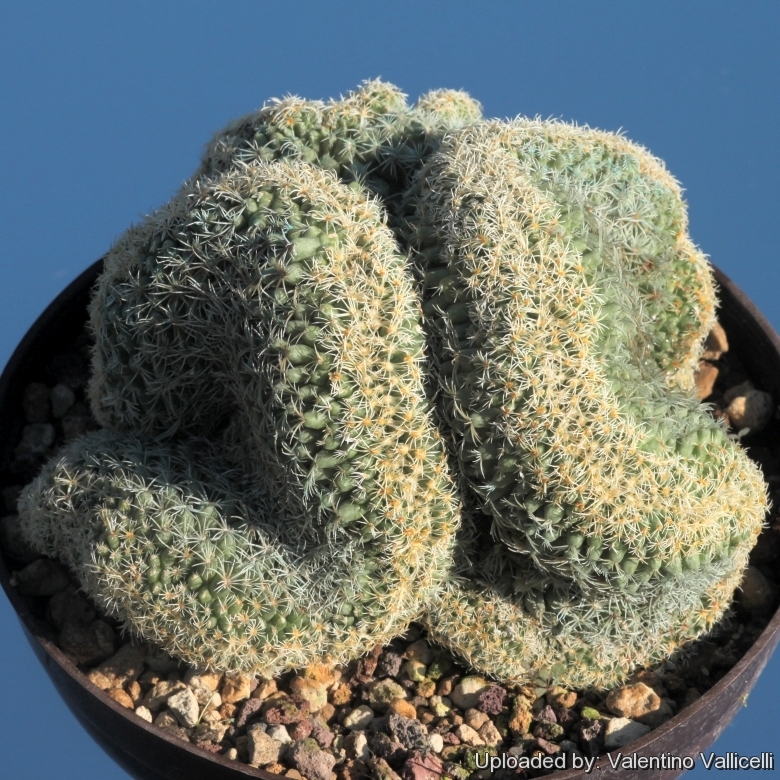
Origin and Habitat: Garden origin (Nursery produced cultivar)
Synonyms:
Coryphantha cornifera (DC.) Lem.
Cactées 35 1868
Synonymy: 31
- Coryphantha cornifera (DC.) Lem.
- Aulacothele cornifera (DC.) Monv.
- Cactus cornifer Kuntze
- Mammillaria cornifera DC.
- Coryphantha bernalensis L.Bremer
- Coryphantha cornifera var. scolymoides (Scheidw.) Borg
- Cactus scolymodes (Scheidw.) Kuntze
- Coryphantha scolymoides (Scheidw.) A.Berger
- Mammillaria cornifera f. scolymoides (Scheidw.) Schelle
- Mammillaria radians var. scolymoides (Scheidw.) Schelle
- Mammillaria scolymoides Scheidw.
- Coryphantha cornuta (Hildm. ex K.Schum.) A.Berger
- Mammillaria cornuta Hildm. ex K.Schum.
- Coryphantha daimonoceras Lem.
- Mammillaria daimonoceras Lem.
- Mammillaria radians var. daimonoceras (Lem.) K.Schum.
- Mammillaria radians f. daimonoceras (Lem.) Schelle
- Coryphantha impexicoma Lem. ex Förster
- Coryphantha radians var. impexicoma (Lem.) Backeb. & F.M.Knuth
- Mammillaria cornifera var. impexicoma (Lem.) Salm-Dyck
- Mammillaria impexicoma Lem.
- Mammillaria radians var. impexicoma (Lem.) Salm-Dyck ex K.Schum.
- Mammillaria radians f. impexicoma (Lem.) Schelle
- Coryphantha maliterrarum L.Bremer
- Coryphantha radians (DC.) Britton & Rose
- Aulacothele radians (DC.) Monv.
- Cactus radians (DC.) Kuntze
- Mammillaria radians DC.
- Coryphantha radians f. cristata hort.
- Coryphantha radians var. pectinoides (J.M.Coult.) Bravo
- Cactus radians var. pectinoides J.M.Coult.
Description: Plants belonging to the genus Coryphantha are solitary cacti with flat globose to cylindrical stems up to 8-15 cm in diameter, 6-12 cm tall with a blunt, depressed apex covered with e wool.
The beautiful crested form here depicted, is supposed by some to be a Coryphantha radiansSN|3908]]SN|3914]] (but further investigation are needed)
Stem: Brain shaped, dull olive-green.
Tubercles: Conical, rhomboid at the base, obliquely cut, grooved above; on new growth the groove may show some felt.
Areoles: Oval to round about 2 mm Ø, at first woolly later naked.
Radial spines: 10 to 20 fairly rigid, pale cream-white to yellowish 3-6 mm long, densely set, horizontal, radiating, straight or slightly curved.
Central spines: Absent.
Roots: Fibrous root or semi-taproot.
Flowers: Not seen.
Fruits: Not seen.
Seeds: Not seen.
Remarks: Coryphantha corniferaSN|3914]]SN|3908]] / radians is a very variable species, normally solitary, rarely sprouting.
Subspecies, varieties, forms and cultivars of plants belonging to the Coryphantha cornifera group
 Coryphantha cornifera (DC.) Lem.
Coryphantha cornifera (DC.) Lem. Coryphantha radians (DC.) Britton & Rose: C. radians and C. cornifera is identical, and at most locations adult plants, either without central spines ("radians"), or with 1-4 central spines ("cornifera") can be found.
Coryphantha radians (DC.) Britton & Rose: C. radians and C. cornifera is identical, and at most locations adult plants, either without central spines ("radians"), or with 1-4 central spines ("cornifera") can be found. Coryphantha radians f. cristata hort.
Coryphantha radians f. cristata hort.
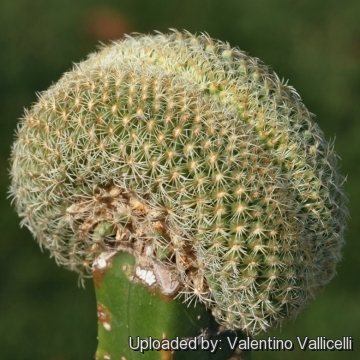
Coryphantha radians f. cristata Photo by: Valentino Vallicelli
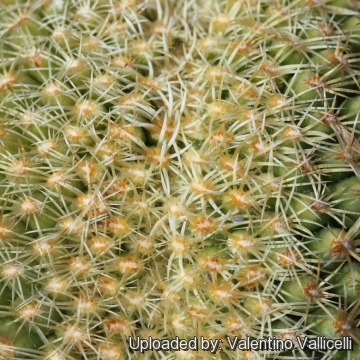
Coryphantha radians f. cristata Photo by: Valentino Vallicelli
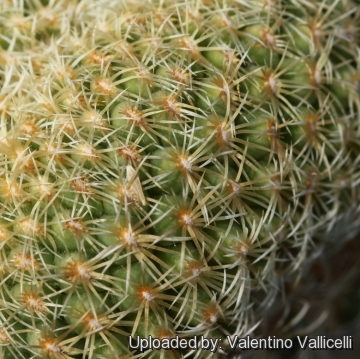
Coryphantha radians f. cristata Photo by: Valentino Vallicelli
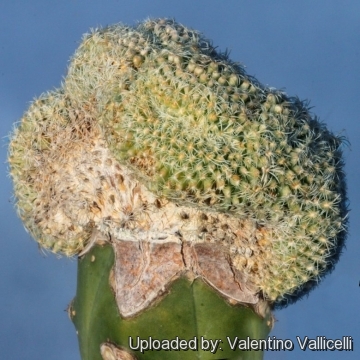
Coryphantha radians f. cristata Photo by: Valentino Vallicelli
Cultivation and Propagation: It is not too difficult in a greenhouse, although grows quite slowly. It is usually seen as a grafted plant but can grow on its own roots too.
Soil: Use a mineral well permeable soil with little organic matter (peat, humus).
Exposure: They need a good amount of light shade to full sun this help to keep the plants healthy, although slow growth.
Watering: Water sparingly from March till October (weekly during summertime, if the weather is sunny enough), with a little fertilizer added. Less or no water during cold winter months, or when night temperatures remain below 10° to prevent root loss. It is sensitive to overwatering (rot prone).
Fertilization: Feeding may not be necessary at all if the compost is fresh then, feed in summer only if the plant hasn't been repotted recently. Do not feed the plants from September onwards as this can cause lush growth which can be fatal during the darker cold months.
Hardiness: Keep perfectly dry in winter at temperatures from 5 to 15 degrees centigrade. (but it is relatively cold resistant and hardy to -5° C, or possibly colder for short periods) In the rest period no high atmospheric humidity!! (Temperature Zone: USDA 9-11)
Crested growth: Unlike 'monstrose' varieties of plants, where the variation from normal growth is due to genetic mutation, crested growth can occur on normal plants. Sometimes it's due to variances in light intensity, or damage, but generally the causes are unknown. A crested plant may have some areas growing normally, and a cresting plant that looks like a brain, may revert to normal growth for no apparent reason. If you have any of the crested part left you need to remove the normal growth and leave the crested part behind this will need to be done regularly.
Propagation: Grafting or cuttings. Plants are usually grafted onto column-shaped cacti but proved to be able to produce their own roots if degrafted. Cuttings will take root in a minimum temperature of 20° C (but better in hot weather). Cuttings of healthy shoots can be taken in the spring and summer. Cut the stem with a sharp, sterile knife, leave the cutting in a warm, dry place for a week or weeks (depending on how thick the cutting is) until a callus forms over the wound. Once the callus forms, the cutting may be inserted in a container filled with firmed cactus potting mix topped with a surface layer of coarse grit. They should be placed in the coarse grit only; this prevents the cut end from becoming too wet and allows the roots to penetrate the rich compost underneath. The cuttings should root in 2 to 6 weeks. Large crested piece must be placed on the soil surface without burying the plant base down in the soil.
| Your Actions | |
|---|---|
| Back to Coryphantha index | |
| Back to Cactaceae index | |
 |
Back to Cacti Encyclopedia index |
Privacy stantement - Terms and conditions - How to cite - About us - Feedback - Donate



